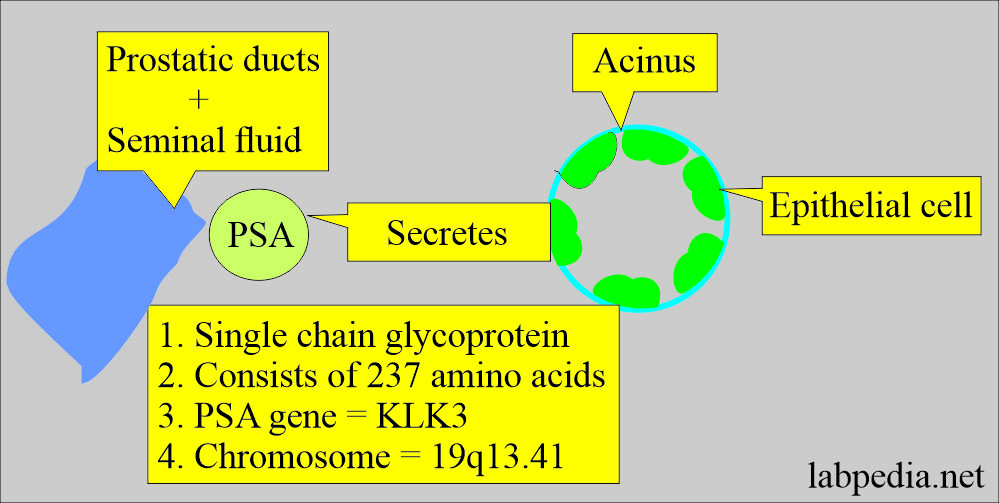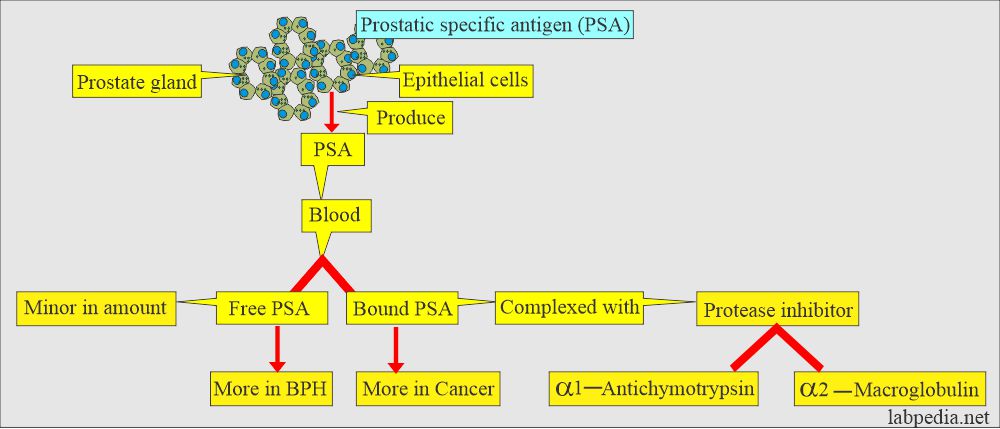Prostatic Specific Antigen (PSA)
Prostatic Specific Antigen (PSA)
What sample is needed for Prostatic Specific Antigen (PSA)?
- This is done on the patient’s serum.
- A random sample can be taken.
- Take the sample before any prostatic procedure is done.
- The sample is stable at 2 to 8 °C for 2 weeks.
What are the precautions for Prostatic Specific Antigen (PSA)?
- Rectal examination may elevate a minimal level. Take the sample before the rectal examination.
- Prostatic biopsy or transurethral resection of the prostate elevates the PSA level.
- Ejaculation within 24 hours of the sample taking will lead to a high value.
- If you have a history of urinary tract infection or prostatitis, your PSA will be elevated five times and remain elevated for at least six weeks.
- Taking a history of medication like Proscar may increase the PSA value.
What are the indications for Prostatic Specific Antigen (PSA)?
- This is a tumor marker for the diagnosis of prostatic carcinoma.
- Prostatic Specific Antigen (PSA) and prostatic acid phosphatase increase the detection of prostatic carcinoma.
- PSA is a good marker for monitoring the effectiveness of the treatment.
- PSA is the early indicator of recurrence.
What is the importance of Prostatic Specific Antigen (PSA)?
- Prostatic Specific Antigen (PSA) has no sensitivity and specificity for diagnosing prostatic carcinoma.
- The ASCP manual claims that this test is highly specific, highly sensitive, and relatively low-cost.
PSA with rectal examination may diagnose nearly 90% of cancers. - PSA is an important tumor marker for prostate cancer:
- It can diagnose.
- It can stage.
- It can monitor the treatment of prostate cancer.
How will you define Prostatic specific antigen (PSA)?
- It is one of the most organic-specific tumor markers.
- Prostatic Specific Antigen (PSA) can detect prostatic cancer in the early stage.
- Early detection for prostatic cancer gives a life expectancy of 10 years.
What is the Prostatic Specific Antigen (PSA) structure?
- Prostatic Specific Antigen (PSA) is a single-chain glycoprotein of 237 amino acids.
- There are four carbohydrate side chains.
- It has a molecular weight of 28,430.
- The carbohydrate linkage occurs at amino acid 45 (asparagine), 69 (serine), 70 (threonine), and 71 (serine).
- The Prostatic Specific Antigen (PSA) gene, KLK3, is located on chromosome 19q13.41.
- Prostatic Specific Antigen (PSA) is produced by the epithelial cells of the acini and secreted into the lumen of prostatic ducts and seminal fluid.
- Prostatic Specific Antigen (PSA) possesses chymotrypsin-like and trypsin-like activity.
- Adding protease inhibitors may be important to prevent the autohydrolysis of PSA in solution.
- Prostatic Specific Antigen (PSA) exists in two forms:
- Free form. It is a free PSA in minor form.
- Complexed form. It is complexed with protease inhibitor-α-antichymotrypsin or with α-macroglobulin
How will you discuss the pathophysiology of Prostatic Specific Antigen (PSA)?
- PSA is a glycoprotein in the cytoplasm of prostate epithelial cells, ducts, and prostatic carcinoma.
- PSA is a kallikrein-serine proteinase produced by the prostate epithelial cells and from malignant prostatic cells.
- PSA is a single-chain glycoprotein found in high concentrations in the prostate.
- Its molecular mass is 28.43 kD.
- It consists of 237 amino acids.
- The gene coding is done, and it is present on chromosome 19.
- This is an antigenic protein.
- PSA possesses chymotrypsin and trypsin-like activity.
- PSA is present in the blood in two forms:
- Free PSA.
- PSA bound to protein.
- In BPH, there is more free PSA, while in cancer, there is more bound PSA.
- It is produced by the epithelial cells of acini and prostate gland ducts.
- PSA is secreted into the prostatic ducts.
- PSA cleaves seminal vesicle-specific proteins into small, low molecular-weight proteins in the seminal fluid.
- The above process leads to the liquefaction of the seminal coagulum.
- The raised level of PSA with increasing age depends upon the following factors:
- Enlargement of the prostate.
- Inflammation of the prostate.
- The presence of microscopic foci of carcinoma is clinically insignificant.
- Leakage of PSA into the serum.
- Levels> 4 ng/mL are found in over 80% of cancer cases.
- The level of PSA also denotes the tumor burden.
- Surgery, radiation, or hormone therapy are associated with decreased PSA levels.
- Later on, an increase in the PSA level indicates the recurrence of the tumor.
- The US Preventive Services Taskforce recommendations are :
- No use of screening by doing PSA after the age of 75 years.
- They also say there is a limited value of PSA for screening under 75 years unless there is a strong family history.
- Their recommendation is PSA screening every four years instead of annual screening.
- The American Urological Society and American Cancer Society have different recommendations.
- They recommend a yearly PSA screening test after the age of 50 years.
- In people with strong family histories and men, Afro-Americans advise PSA at the age of 40 years.
- PSA has a long half-life of 2 to 3 weeks when serum comes to a normal level or baseline after any procedure on the prostate.
- PSA levels may not be raised in the early stages of Prostatic carcinoma.
- PSA has a limited diagnosis value in the gray zone of 4 to 10 ng/mL.
- Benign prostatic hyperplasia shows values of 4 to 8 ng/mL.
- Levels>8 ng/mL are highly suggestive of prostatic cancer.
- Low level is due to benign prostatic hyperplasia or early prostatic cancer.
- If Prostatic cancer is completely removed, then PSA will not be detected.
- Patients below 10 ng/mL have the local disease and respond well to local treatment.
- After complete curative surgery or radiation therapy, the PSA level will be 0 to 0.5 ng/mL.
What is the normal Prostatic Specific Antigen (PSA)?
Source 1
| Healthy male: % of the population | ng/mL |
|
|
|
|
|
|
|
|
- To convert into SI units x 1.0 = µg/L
Source 3
- Men = <4.0 ng/mL
- PSA value increases with age.
Another source
- Healthy Male less than 40 years of age = 0 to 2.5 ng/mL
- Healthy males above 40 years of age :
- < 4.0 ng/mL in 96 %.
- 4 to 10 ng/mL in 4 %
- Benign Prostatic Hyperplasia
- <4 ng/mL in 90 %.
- 4—10 ng/mL in 10 %.
- > 10 ng/mL in 1 %
- Prostatic cancer :
- < 4 ng/mL in 15 % .
- 4 – 10 ng/mL in 20 %.
- > 10 ng/mL in 65 %
- Free PSA = more in BPH.
- Bound PSA = more in cancers.
- Free PSA <25%, then more chances of cancer.
Source 4
- PSA : Men = 0 to 4.0 ng/mL or 0 to 4.0 µg/L
- 4.0 to 8.0 ng/mL suggests Benign prostatic hyperplasia or possible prostatic Cancer.
- >4.0 ng/mL is reported in 8% of the cases with no malignancy or benign disease.
- >8.0 ng/mL is highly suggestive of prostatic cancer.
Another source
- The suggested age-specific PSA reference ranges:
- 0 to 2.5 ng/mL for 40 to 49 years.
- 0 to 3.5 ng/mL for 50 to 59 years.
- 0 to 4.5 ng/mL for 60 to 69 years.
- 0 to 6.5 ng/mL for 70 to 79 years
- If prostatic cancer is completely removed, then no PSA will be detected.
What are the causes of increased prostatic specific antigen (PSA)?
- Prostatic cancers.
- Benign prostatic hyperplasia.
- Prostatitis.
- Prostatic infarction.
- In the case of rectal manipulation of the prostate.
What is the relationship between free PSA and the possibility of cancer?
| Free PSA % | The possibility of cancer in % |
|---|---|
|
|
|
|
|
|
|
|
|
|
What are the recommendations for Prostatic Specific Antigen (PSA)?
- This has high specificity, high sensitivity, and low cost.
- Men over 50 years are advised for early diagnosis:
- PSA.
- Rectal examination.
- PSA correlates with pathological stages of tumor extension and metastasis.
- A higher PSA level is associated with the advanced pathological stage.
- Tumor confined to the prostate seldom has PSA >50 ng/mL.
- PSA level <20 ng/mL rarely causes bone metastasis.
What is the interpretation of the Prostatic Specific Antigen (PSA)?
| Prostatic Specific Antigen (PSA) level/DRE | Interpretations |
| PSA detects | Only 2% of healthy asymptomatic males |
| PSA = 4.0 to 10.0 ng/mL | 20% of the patients with BPH |
| DRE (Direct rectal examination) | ∼50% of confined prostatic cancer. It increases with raised PSA |
| PSA = <4.0 ng/mL | ∼45% of cancers are confined, and 25% are unconfined cancers |
| PSA = >10 ng/mL | 2% cases of BPH and 44% cases of prostatic cancers |
| Staging of patients with prostatic cancer | |
| <4 ng/mL | There is prostate-confined cancer |
| <10 ng/mL | Bone metastasis is rare |
| >10 ng/mL | >50% have an extracapsular disease |
| >50 ng/mL | Most of the patients have positive lymph nodes |
| >100 ng/mL |
|
What will be the response after the surgical treatment?
- After radical prostatectomy = The PSA level is below the detection limit.
- This will drop after 2 to 3 weeks of the surgery.
- Measure the PSA the first year after the surgery = every third month.
- Measure the PSA the second year after the surgery = every fourth month.
- Measure the PSA the third year after the surgery = every 6 months.
- After one year of the surgery, 50% of the cases show a rise in the PSA level, indicating positive biopsy and metastasis.
- Antiandrogen therapy includes:
- Bilateral Oophorectomy.
- LH- LH-releasing hormone analog-like diethylstilbesterol and Flutamide are given.
What is the interpretation of the PSA for prostatic cancers?
| Chances for prostatic cancer | PSA level 0 to 2.0 ng/mL | PSA 2 to 4 ng/mL | PSA 4 to 10 ng/mL | PSA >10 ng/mL |
| Direct rectal examination = negative |
|
|
|
|
| Direct rectal examination = positive |
|
|
|
|
- Importance: Tumor confined to the prostate is curable by surgery. Therefore, early detection is very important.
Questions and answers:
Question 2: What is the level of PSA at 40 years?
after the age of 50 years, PSA and rectal examination.”]


